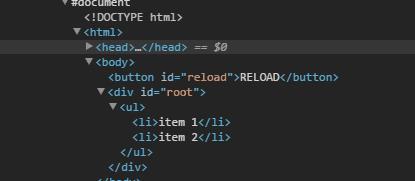从0到1实现一个虚拟DOM
Posted web前端开发
tags:
篇首语:本文由小常识网(cha138.com)小编为大家整理,主要介绍了从0到1实现一个虚拟DOM相关的知识,希望对你有一定的参考价值。
Virtual DOM 是真实 DOM 的映射
当虚拟 DOM 树中的某些节点改变时,会得到一个新的虚拟树。算法对这两棵树(新树和旧树)进行比较,找出差异,然后只需要在真实的 DOM 上做出相应的改变。
用 JS 对象模拟 DOM 树
<ul class="”list”">
<li>item 1</li>
<li>item 2</li>
</ul>
{ type: ‘ul’, props: { ‘class’: ‘list’ }, children: [
{ type: ‘li’, props: {}, children: [‘item 1’] },
{ type: ‘li’, props: {}, children: [‘item 2’] }
] }
用如下对象表示 DOM 元素
{ type: ‘…’, props: { … }, children: [ … ] }
用普通 JS 字符串表示 DOM 文本节点
function h(type, props, …children) {
return { type, props, children };
}
h(‘ul’, { ‘class’: ‘list’ },
h(‘li’, {}, ‘item 1’),
h(‘li’, {}, ‘item 2’),
);
<ul className="”list”">
<li>item 1</li>
<li>item 2</li>
</ul>
React.createElement(‘ul’, { className: ‘list’ },
React.createElement(‘li’, {}, ‘item 1’),
React.createElement(‘li’, {}, ‘item 2’),
);
h(...)
函数代替
React.createElement(…)
,那么我们也能使用 JSX 语法。其实,只需要在源文件头部加上这么一句注释:
/** @jsx h */
<ul className="”list”">
<li>item 1</li>
<li>item 2</li>
</ul>
h(...)
函数代替
React.createElement(…)
,然后 Babel 就开始编译。’
/** @jsx h */ const a = (
<ul className="”list”">
<li>item 1</li>
<li>item 2</li>
</ul>
);
const a = (
h(‘ul’, { className: ‘list’ },
h(‘li’, {}, ‘item 1’),
h(‘li’, {}, ‘item 2’),
);
);
“h”
执行时,它将返回普通 JS 对象-即我们的虚拟 DOM:
const a = (
{ type: ‘ul’, props: { className: ‘list’ }, children: [
{ type: ‘li’, props: {}, children: [‘item 1’] },
{ type: ‘li’, props: {}, children: [‘item 2’] }
] }
);
从 Virtual DOM 映射到真实 DOM
使用以’
$‘开头的变量表示真正的 DOM 节点(元素,文本节点),因此 $parent 将会是一个真实的 DOM 元素虚拟 DOM 使用名为
node的变量表示
createElement(…)
,它将获取一个虚拟 DOM 节点并返回一个真实的 DOM 节点。这里先不考虑
props
和
children
属性:
function createElement(node) {
if (typeof node === ‘string’) {
return document.createTextNode(node);
}
return document.createElement(node.type);
}
{ type: ‘…’, props: { … }, children: [ … ] }
createElement
传入虚拟文本节点和虚拟元素节点——这是可行的。
appendChild()
添加到我们的元素中:
function createElement(node) {
if (typeof node === ‘string’) {
return document.createTextNode(node);
}
const $el = document.createElement(node.type);
node.children
.map(createElement)
.forEach($el.appendChild.bind($el));
return $el;
}
props
属性放到一边。待会再谈。我们不需要它们来理解虚拟 DOM 的基本概念,因为它们会增加复杂性。
/** @jsx h */
function h(type, props, ...children) {
return { type, props, children };
}
function createElement(node) {
if (typeof node === "string") {
return document.createTextNode(node);
}
const $el = document.createElement(node.type);
node.children.map(createElement).forEach($el.appendChild.bind($el));
return $el;
}
const a = (
<ul class="list">
<li>item 1</li>
<li>item 2</li>
</ul>
);
const $root = document.getElementById("root");
$root.appendChild(createElement(a));
比较两棵虚拟 DOM 树的差异
添加新节点,使用 appendChild(…) 方法添加节点

移除老节点,使用 removeChild(…) 方法移除老的节点

节点的替换,使用 replaceChild(…) 方法


$parent、newNode 和 oldNode,其中 $parent 是虚拟节点的一个实际 DOM 元素的父元素。现在来看看如何处理上面描述的所有情况。
添加新节点
function updateElement($parent, newNode, oldNode) {
if (!oldNode) {
$parent.appendChild(createElement(newNode));
}
}
移除老节点
$parent.removeChild(…)
方法把变化映射到真实的 DOM 上。但前提是我们得知道我们的节点在父元素上的索引,我们才能通过 $parent.childNodes[index] 得到该节点的引用。
function updateElement($parent, newNode, oldNode, index = 0) {
if (!oldNode) {
$parent.appendChild(createElement(newNode));
} else if (!newNode) {
$parent.removeChild($parent.childNodes[index]);
}
}
节点的替换
function changed(node1, node2) {
return typeof node1 !== typeof node2 ||
typeof node1 === ‘string’ && node1 !== node2 ||
node1.type !== node2.type
}
function updateElement($parent, newNode, oldNode, index = 0) {
if (!oldNode) {
$parent.appendChild(createElement(newNode));
} else if (!newNode) {
$parent.removeChild($parent.childNodes[index]);
} else if (changed(newNode, oldNode)) {
$parent.replaceChild(createElement(newNode), $parent.childNodes[index]);
}
}
比较子节点
当节点是 DOM 元素时我们才需要比较( 文本节点没有子节点 )
我们需要传递当前的节点的引用作为父节点
我们应该一个一个的比较所有的子节点,即使它是
undefined也没有关系,我们的函数也会正确处理它。最后是 index,它是子数组中子节点的 index
function updateElement($parent, newNode, oldNode, index = 0) {
if (!oldNode) {
$parent.appendChild(createElement(newNode));
} else if (!newNode) {
$parent.removeChild($parent.childNodes[index]);
} else if (changed(newNode, oldNode)) {
$parent.replaceChild(createElement(newNode), $parent.childNodes[index]);
} else if (newNode.type) {
const newLength = newNode.children.length;
const oldLength = oldNode.children.length;
for (let i = 0; i < newLength || i < oldLength; i++) {
updateElement(
$parent.childNodes[index],
newNode.children[i],
oldNode.children[i],
i
);
}
}
}
完整的代码
/*_ @jsx h_ /
function h(type, props, ...children) {
return { type, props, children };
}
function createElement(node) {
if (typeof node === "string") {
return document.createTextNode(node);
}
const $el = document.createElement(node.type);
node.children.map(createElement).forEach($el.appendChild.bind($el));
return $el;
}
function changed(node1, node2) {
return (
typeof node1 !== typeof node2 ||
(typeof node1 === "string" && node1 !== node2) ||
node1.type !== node2.type
);
}
function updateElement($parent, newNode, oldNode, index = 0) {
if (!oldNode) {
$parent.appendChild(createElement(newNode));
} else if (!newNode) {
$parent.removeChild($parent.childNodes[index]);
} else if (changed(newNode, oldNode)) {
$parent.replaceChild(createElement(newNode), $parent.childNodes[index]);
} else if (newNode.type) {
const newLength = newNode.children.length;
const oldLength = oldNode.children.length;
for (let i = 0; i < newLength || i < oldLength; i++) {
updateElement(
$parent.childNodes[index],
newNode.children[i],
oldNode.children[i],
i
);
}
}
}
// ---------------------------------------------------------------------
const a = (
<ul>
<li>item 1</li>
<li>item 2</li>
</ul>
);
const b = (
<ul>
<li>item 1</li>
<li>hello!</li>
</ul>
);
const $root = document.getElementById("root");
const $reload = document.getElementById("reload");
updateElement($root, a);
$reload.addEventListener("click", () => {
updateElement($root, b, a);
});
<button id="reload">RELOAD</button>
<div id="root"></div>
#root {
border: 1px solid black;
padding: 10px;
margin: 30px 0 0 0;
}

总结
设置元素属性(props)并进行 diffing/updating
处理事件——向元素中添加事件监听
让虚拟 DOM 与组件一起工作,比如 React
获取对实际 DOM 节点的引用
使用带有库的虚拟 DOM,这些库可以直接改变真实的 DOM,比如 jQuery 及其插件
以上是关于从0到1实现一个虚拟DOM的主要内容,如果未能解决你的问题,请参考以下文章
从 0 到 1 实现 React 系列 —— 4.setState优化和ref的实现